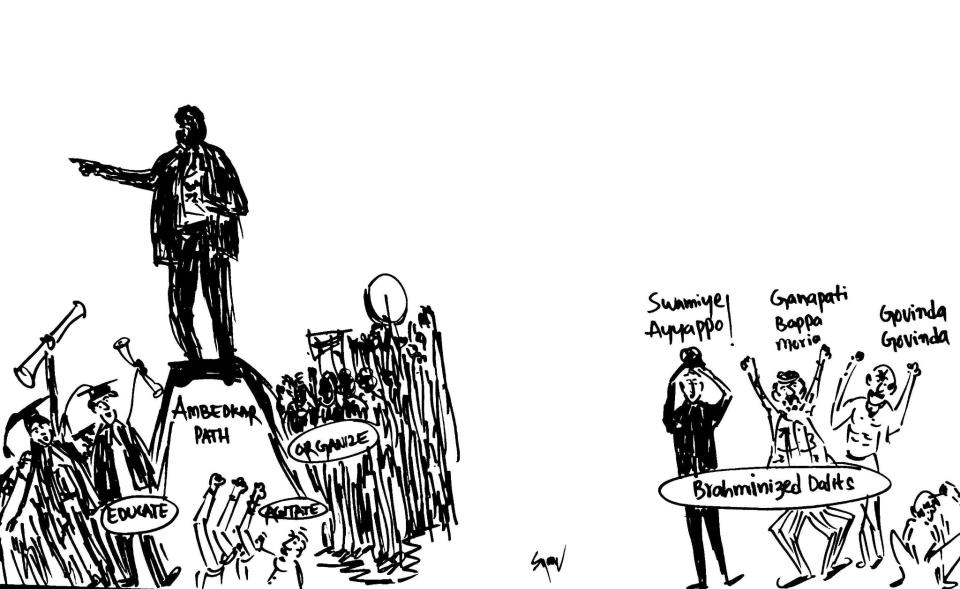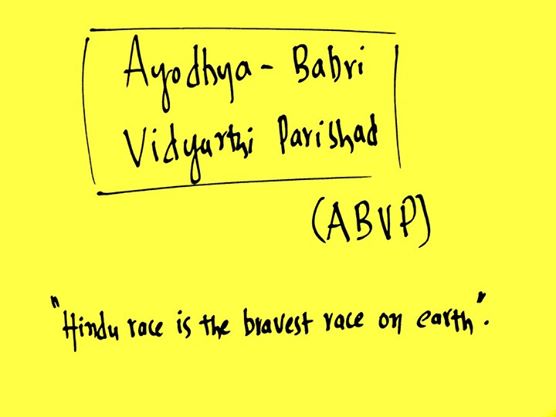‘Under your fascist sky
Slowly pants the terrified dalit ghetto.’*
Raju Solanki
(Raju Solanki is an activist and poet based in Gujarat. These are a few of his notes on Gujarat, the state of Dalits, minorities and other marginalized sections under the Modi regime. They provide keen insights into how ‘Moditva’ works and its varna-embedded philosophical underpinnings. Above all, they also chronicle the resolute and persistent Dalit struggles against the Hindutva hegemony, in every field)
~
Social Justice
The system of untouchability has been a goldmine for the Hindus. This system affords 60 millions of untouchables to do the dirty work of scavenging and sweeping to the 240 million Hindus who are debarred by their religion to do such dirty work. But the work must be done for the Hindus and who else than the untouchables?
~ Dr. B R Ambedkar.
What is social justice? An overdosed, over-used cliché or a marketing strategy to create a niche? For Dalits in Gujarat, the official meaning of social justice is different. To begin the exercise, let us read the Gujarat villages Panchayats’ Social Justice Committee (Constitution and Functions) rules, 1995, i.e. the Panchayat rules, 1995.
 According to The Panchayat rules, 1995, one of the functions of this so-called Social Justice Committee is “to ensure systematic disposal of carcasses and to provide means for the disposal of unclaimed corpses and carcasses and to define places for the purpose of disposal of unclaimed corpses and carcasses.”
According to The Panchayat rules, 1995, one of the functions of this so-called Social Justice Committee is “to ensure systematic disposal of carcasses and to provide means for the disposal of unclaimed corpses and carcasses and to define places for the purpose of disposal of unclaimed corpses and carcasses.”
The Social justice committee comprises, one member belonging to the Valmiki (Safai Kamdar) Community, three members belonging to the Scheduled Castes and Scheduled Tribes and one woman member from Scheduled Castes.
It is very clear that the government has imposed the duty of disposing dead animals on the Social Justice Committee. This provision or legal obligation reveals the official meaning of social justice. Ironically enough, The Civil Rights Protection Act, 1995 declares such kind of acts as enforcement of untouchability.
The section 7 (a) 1 of the said act says: “The compelling of any person out of ‘untouchability’ to do scavenging, sweeping, removing of carcasses, flaying of animals or removing of umbilical cord has been made punishable.”
What kind of punishment Dalits of Gujarat would declare for their foolish, semi-literate, wretched representatives who remained silent in the legislative assembly during the enactment of this pernicious act? Panchayat Rules, 1995 is marked with unacceptable logic and unrealistic assumptions of our law-makers. Look at some functions of the committee.
(b) To look after street-light facility of the weaker sections of the society, provided there are street-lights in the village.
(g) To look after bathing and washing facility for the weaker sections of the society, provided such facilities exist for general public.
The meaning: The weaker sections should never aspire for street-lights, bathing and washing facility, if such facilities do not exist for ‘general’ public!
Panchayat rules, 1995 repealed the earlier act of 1975, i.e., the Gujarat Gram and Nagar Panchayat Social Justice Committee (Constitution and Functions) Rules, which was enacted during Congress rule. Thus, the meaning of social justice has not changed in either a pseudo-secularist state or in a Hindu-nationalist state!
Atrocious Ignorance of a Chief Minister
Under The Scheduled Castes and Scheduled Tribes (Prevention of Atrocities) Act, 1989, it is the duty of District Superintendent of Police (DSP) to appoint an officer not below the rank of DySP as an investigating officer for the offences registered under the same act. This provision is quite well-known.
 On 16 April, 2004, MLA from Jamnagar Rural asked a question to chief minister Modi in Gujarat legislative assembly: “Honorable chief minister [Home] may oblige us to tell that, is it true that the DSP is responsible for the appointment of an officer not below the rank of DySP as investigating officer in the offences under atrocities act? The answer of our chief minister is shocking. He said: “No, but there is a provision under rule 7 (1) of SC/ST act, 1995 to appoint officers not above the rank of DySP to inquire into all cases booked under atrocities act. It is not the responsibility of DSP.“
On 16 April, 2004, MLA from Jamnagar Rural asked a question to chief minister Modi in Gujarat legislative assembly: “Honorable chief minister [Home] may oblige us to tell that, is it true that the DSP is responsible for the appointment of an officer not below the rank of DySP as investigating officer in the offences under atrocities act? The answer of our chief minister is shocking. He said: “No, but there is a provision under rule 7 (1) of SC/ST act, 1995 to appoint officers not above the rank of DySP to inquire into all cases booked under atrocities act. It is not the responsibility of DSP.“
“The officer not above the rank of DySP” means he may be a P.S.I. or P.I. and in most of the atrocities cases courts acquit the accused because the investigation officer is either P.S.I. or P.I. Over 150 such judgments collected by the Council for Social Justice revealed that in 95% of the cases, the accused have been acquitted because of negligence on part of the authorities. In number of these cases, while the accused has been convicted under IPC section for murder and attempt to murder, he has gone scot-free on the atrocity charge.
In one judgment, an honorable judge even went on to say that, “the government of Gujarat has in the year 1999 passed a resolution amending the Atrocities Act 1989, whereby the investigation can be undertaken even by a police officer not below the rank of P.I.” The Atrocities Act was enacted by parliament of India. No state government can pass any resolution to amend the act. When the chief minister and a judge both possess utter ignorance about an important act, what can we expect from an ordinary constable or clerk of this machinery?
Social Welfare or Fanfare?

Year 2004. Gujarat Safai Kamdar Vikas Nigam organized a function to distribute cheques worth Rs. 1,56,88,780 to 149 persons belonging to Valmiki community. In Gujarat, more than one lakh families of Valmiki not only live below poverty line, but way below human dignity line, too. They still carry human excreta on their heads. Rs. 1.56 crore is nothing but peanuts and a cruel joke on a section of people who are, still reeling under the curse of Hinduism, untouchability.
Details of deaths and injuries caused to sweepers while cleaning underground sewerage systems and sewage tanks are mentioned below. The shocking list is based on Gujarati newspaper clippings covering the period 1989 to 2003:
1. Two brothers drowned and died of asphyxiation caused by poisonous gas while descending to clean sewerage. [21 February, 1989, Umreth, Jansatta, Anand]
2. In sewage disposal work during the last six years, 11 employees died while on duty and 20 others persons died of tuberculosis, cancer, paralysis, heart disease and respiratory problems. Every year about 3 to 4 young employees succumb to untimely death due to this suffocating and gaseous atmosphere. [17 July 1989, Gujarat Samachar, Vadodara]
3. Cleaning the drainage line of Calico Polyester Fiber, two sweepers were drowned and died of asphyxiation caused by poisonous gas inside the 50 feet deep gutter. [31 August 1989, Sandesh, Vadodara]
4. Two workers descended to clean underground sewerage near C.M.C. Factory, off Odhav Road. They died of asphyxiation. [24 September 1989 Sandesh, Vadodara]
5. Two laborers died inside a gutter when they descended to clean sewerage near Bhagwannagar Chhapra, Navrangpura. [11 August 1990 Jansatta, Ahmedabad]
6. During unearthing a manhole of a sewerage line which was under construction near Narnarayan Society, Maninagar, three persons were seriously injured. Amongst them one woman labourer lost her consciousness and the other two succumbed to death during treatment. [17 August 1990 Jansatta Ahmedabad]
7. Ranchhod Dhana Harijan and Kanti Dhana Harijan became unconscious due to poisonous gas while cleaning underground sewage tank of Ambalal Patel. [3 December 1990 Pipariya,Taluka Vaghodara,Sandesh]
8. One labourer died due to poisonous gas while cleaning sewerage near Gitamandir Bus-stand. [26 March 1991 Ahmedabad]
9. Three workers died of asphyxiation when they were cleaning underground sewage tank in the premises of a private company. [23 July 1992 Jansatta, Ahmedabad]
10. Having descended to clean one underground sewage tank, two young laborers drowned and died. [23 March 1992 Jansatta, Surat]
11. Ramesh Harijan and Jagu Nadia, while cleaning the sewerage on the main road in Karelibaug area of Ward: 8 in Baroda, became unconscious due to poisonous gas of the sewerage. [23 March 1992 Gujarat Samachar, Vadodara]
12. Mangal Solanki, who descended to clean sewerage in Nizampura, became unconscious due to poisonous gas inside the sewerage. [18 July 1992 Gujarat Samachar, Vadodara]
13. Kalidas Chauhan, residing behind Pratapnagar police chawki, was burnt while cleaning sewerage in Gajarwasi, Pareshnagar. The cause of injury was surprising. Kalidas descended into the sewerage with a lit bidi in his hand. When it came into contact with the gaseous atmosphere, it caused burns and injury. [4 April 1993 Sandesh, Vadodara]
14. Three young workers died of asphyxiation when they descended into sewerage during work of drainage connection at Rander Road. They were Chhagan Bhila, Sursing Jhala, Tagga Parima. [4 April 1993, Fulchnab, Surat]
15. Laljibhai Chaturbhai Vasava and Ladhubhai Sukabhai Vasava descended to clean a sewage tank in Gamadiwad of Vejalpore at Bharuch. They died of asphyxiation caused by poisonous gas of sewage tank. [6 May 1993 Loksatta, Bharuch]
16. One sweeper became unconscious while cleaning sewerage. [19 March 1994, Sandesh Ahmedabad]
17. Two died and one was seriously injured due to poisonous gas at Pirana sewage pumping station. [23 May 1994 Gujarat Samachar Ahmedabad]
18. Two died and three were seriously injured due to asphyxiation caused by poisonous gas inside sewerage. [14 June 1995 Gujarat Samachar, Ahmedabad]
19. Two died of asphyxiation caused by poisonous gas while cleaning sewerage system in Vastrapur. [14 June 1995 Gujarat Samachar Ahmedabad]
20. Two employees of Municipal Corporation died of asphyxiation while cleaning sewerage in Pandesara GIDC. [10 October 1995 Gujarat Mitra, Surat]
21. Chunibhai Gandabhai Chaudhary, a sweeper in Mandavi Gram Panchayat, died of asphyxiation in 30 feet deep drain full of sewage. [23 August 1996 Gujarat Mitra, Surat]
22. At midnight, the dead body of a sweeper Valjibhai Sanabhai was found from a drainage in Bapunagar. He had descended to clean the gutter. [21st October 1996, Gujarat samachar Ahmedabad]
23. Two brothers descended to clean the manhole of sewerage system at Hotel Grand Bhagwati, one died, the other was serionsly injured. [24 June 2004, Sandesh, Ahmedabad]
This list shows that 54 sweepers were killed during 1989 to 2004. The reality must have been more shocking than what has been reported in the newspapers. We must ask a simple question to our Ministers, politicians and bureaucrats who are fond of holding cheque distribution ceremonies under full glare of T.V. cameras, whether they have ever taken care to provide adequate compensation to these mute victims of this pernicious system? Does Mr. Narendra Modi bother to consider these sweepers as Hindus only when he decides to author state-sponsored genocides?
Dogs, Cats and Dalits: The beasts without a burial ground
What is the similarity between dogs, cats and Dalits in India? All of them have no burial ground. And as a matter of fact, sometime dogs and cats do have specific burial grounds; Dalits do not have such a place where they can bury their dead. Sounds strange! But it is the bitter truth and a simple fact of life in most of the villages of Gujarat.
Very few people know that the practice of Dalits burying their dead was one of the ten tests which were laid down by the census of 1911 to mark off untouchables from those who were touchable. Dalits being the most marginalized and oppressed community didn’t have a legally defined, specific piece of land where they could bury their dead. The situation has not changed in 21st century.
Ruppur: Fight for burial place

When some 80 helpless, landless families marched across dusty, narrow lanes of Ruppur village (district Patan) in the afternoon of 9th April 2003. The banners hung on their camel carts had slogans which were asking, “When the question of Ram taking birth at a particular place 5000 years ago is described as a matter of Hindu sentiment should we remain silent when Dalits’ sentiment for their graveyard is crushed?” And “Is this the way to materialize the pledge of Hindu Rashtra?”
In Ruppur not only Dalits but Ravals (OBC) too, have been burying their dead in the graveyard, the land which has now become prime land due to the newly built Chanashma-Patan highway. The land of graveyard was recorded as gauchar (grazing land) instead of burial ground. The upper caste, namely Patels of the village, grabbed the land measuring 12,468 square meters on rent of just one rupee from the government. When Dalits and Ravals protested against the upper caste-bureaucratic nexus, they were socially boycotted. They met the district collector for help, he simply gathered written statements of caste-Hindus and reported that there was no social boycott as such.
Ultimately 85 families, including 55 of Dalits and 30 of Ravals, migrated to the district collector’s office at Patan. Later on, the collector accepted the burial rights of Dalits and the High Court, too, considered the decision of collector in a writ petition filed by the Council for Social Justice. The matter does not end here. So many Ruppurs are, still, waiting to happen in rural Gujarat.
Rupur is the village of Karsan Patel, the richest person of Gujarat. When Karsan’s relatives were oppressing, suppressing, insulting, humiliating and intimidating Dalits, the ‘civil society’ was watching atrocities with its trademark silence. And when same Karsan Patel attempted to seize fertile land of Mahuva, a historical agitation (in their words and world!) was launched….. The upper caste hindus are not ready to recognise movements of dalits. For them dalits are ‘project material’, dalits cannot be leaders!
Kunvarbai Nu Mameru: Beggars Have No Choice
 ‘Mameru’ is a gift of some precious ornaments given by a maternal uncle to his niece on the occasion of her marriage ceremony. In Gujarat we call maternal uncle, ‘mama’ and hence whatever mama gives is ‘mameru’.
‘Mameru’ is a gift of some precious ornaments given by a maternal uncle to his niece on the occasion of her marriage ceremony. In Gujarat we call maternal uncle, ‘mama’ and hence whatever mama gives is ‘mameru’.
‘Kunvarbai nu mameru’ is a government scheme to donate Mangal Sutras to Scheduled Caste brides. Mangal Sutra is again an ornament, which is given by a husband to his wife. In fact, BJP government, the political husband of Scheduled Castes, gives Mangal Sutra in the name of mameru. Any sensible Dalit having a feeling of self-respect would refuse such a thing.
Narasinh Mehta, father of Kunvarbai was a saint of 11th century. He was a poor, unskilled Brahmin, not efficient in any trade to earn livelihood. He used to wonder with his tambura (a desi musical instrument). It is said that on his daughter’s marriage, Lord Krishna appeared, personated as Sheth Sagalshah, and gave money to the needy father. Are we, Dalits, Narsinh Mehtas, poor and unskilled? Kunvarbai nu Mameru is a glaring example of BJP’s hypocrisy and mawkish populism which has nothing to do with emancipation of Dalits.
Satyawadi Raja Harishchandra Maranottar Sahay Yojana
(A scheme to subsidize funerals of Dalits)
The government gives Rs. 1,500 to perform last rituals of a Dalit. Why has the name of “Satyawadi Raja Harishchandra” been given to this scheme? According to myth, Rishi Vishawamitra cursed king Harishchandra, who became servant of a dom (chandal, an untouchable). When Queen Satyavati, wife of Harishchandra, tried to perform last rites of their son, at river Ganga, Harishchandra prevented her because she had no money to pay the tax to the Chandal. Thus, a Kshatriya couple was humiliated and could not perform last rites of their son. Saffron ideologues have not forgotten the humiliation of their mythical ancestors two thousand years ago.
Please read the next part of notes here.
~~~
Raju Solanki is a leading dalit poet and activist, and a freelance journalist. He is the President of Jati Nirmulan Sangh. As an activist, he has made important contributions towards dalit solidarity with women and minority groups. His collection of poetry is Mashal (1986), and his street play, Bamanvadni Barakhdi (c.1986). He regularly recites poetry with writers from other marginalized groups in slums for social change. His poetry is versatile with the powerful depiction of caste, gender, and religion politics.
He blogs here.
* A line from ‘The dalit ghetto’, a translation of a poem by Raju Solanki. You can read it here.









